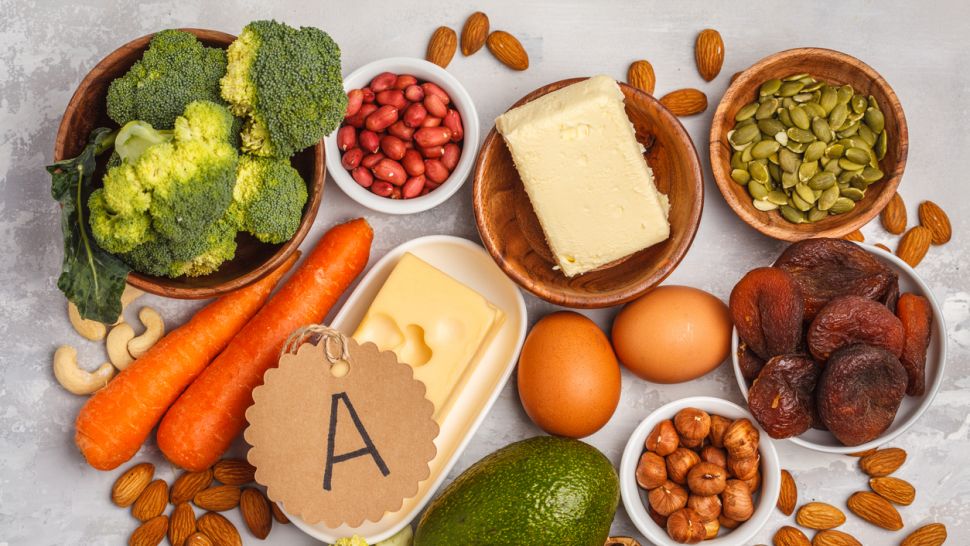Vitamin A is a fat-soluble vitamin that is essential for maintaining health. The term “vitamin A” encompasses a group of related compounds, including active vitamin A and its precursors known as provitamin A carotenoids.
Vitamin A is found in both animal and plant foods, although in different forms. One of the active forms of the vitamin, retinol, is present in animal products such as meat and eggs. Precursors, or provitamin forms of the vitamin, include the carotenoids beta-carotene, alpha-carotene, and beta-cryptoxanthin. These carotenoids are found in plants and often give a yellow-orange color to various fruits and vegetables.
Active vitamin A plays a key role in maintaining vision, immune system health and cell growth. Carotenoids, on the other hand, are converted in the body to active vitamin A and also contribute to these vital functions.
What is the function of vitamin A in the body?
Vitamin A is essential for cell growth and development. It plays a key role in vision, immune function, reproduction, bone health and gene regulation. This vitamin is especially important during childhood development. In countries where dietary levels of vitamin A are low, vitamin A supplementation reduces infant mortality by 24%. Children with severe deficiency may develop eye damage leading to blindness. It is for this reason that experts recommend that all children at risk of deficiency receive vitamin A supplements because of the significant health benefits.
One of the main functions of vitamin A is the genetic regulation of cell division. This process allows cells to specialize by becoming muscle or nerve cells. Vitamin A is needed for the production of specialized cells throughout the body.
Bone health also depends on vitamin A levels. Research shows that both too low and too high amounts of the active form of the vitamin increase the risk of osteoporosis. However, these risks do not apply to dietary provitamin A carotenoids, which are even associated with a reduced risk of osteoporosis. Provitamin A carotenoids are also associated with a reduced risk of cognitive decline and dementia according to some studies.
How Much Vitamin A Do You Need?
Because active vitamin A and provitamin A carotenoids have different potencies, the term “retinol activity equivalents” (RAE) was developed to facilitate comparisons between the two forms. This simplifies food labels as vitamin A levels are measured in RAEs.
To make it clearer:
- 1 microgram retinol (active vitamin A) = 1 microgram RAE.
- 2 micrograms of beta-carotene from supplements = 1 microgram RAE.
- 12 micrograms of beta-carotene from food = 1 microgram RAE.
- 24 micrograms of alpha-carotene or beta-cryptoxanthin from food = 1 microgram RAE.
Recommended daily allowances (RAE) by age and sex:
- Infants 0-6 months: 400 mcg RAE
- Infants 7-12 months: 500 mcg RAE
- Children 1-3 years: 300 mcg RAE
- Children 4-8 years: 400 mcg RAE
- Children 9-13 years: 600 mcg RAE
- Males 14+ years: 900 mcg RAE
- Women 14+ years: 700 mcg RAE
- Pregnant women (14-18 years): 750 mcg RAE
- Pregnant women (19-50 years): 770 mcg RAE
- Lactating women (14-18 years): 1200 mcg RAE
- Lactating women (19-50 years): 1300 mcg RAE
These recommendations reflect the body’s need for vitamin A to maintain good health and the normal functioning of various systems.
Vitamin A deficiency
As previously mentioned, vitamin A is critical for children’s development, and deficiency can lead to increased susceptibility to infections, blindness, skin rashes, and other developmental abnormalities. Low vitamin A has also been shown to increase the risk of bone loss and osteoporosis.
Vitamin A excess
Excessive intake of active vitamin A can be dangerous, even fatal, in very high doses. An excess of carotenoids, in turn, can cause a harmless orange discoloration of the skin. Large amounts of carotenoids are deposited in the skin, which can be seen in the coloring of the palms. However, even at high consumption, carotenoids from food sources are considered safe.
Food sources of vitamin A
Active vitamin A
Active vitamin A or retinol is found in a number of food products of animal origin. Meat, eggs, seafood, poultry and dairy products contain active vitamin A. Liver is quite high in active vitamin A, and cod liver oil is a particularly rich source of this vitamin.
Provitamin A carotenoids
Foods that are deep orange to yellow in color are often rich sources of provitamin A. Carrots, squash, winter squash, sweet potatoes, apricots, cantaloupe, green leafy vegetables, peppers, grapefruit, and broccoli are good sources of provitamin A carotenoids.
A number of so-called superfoods are also rich in carotenoids. Red palm oil has extremely high levels of this vitamin. Another rich source of provitamin A is goji berries. They are also extremely rich in another carotenoid potentially important for eye health: zeaxanthin. Spirulina and chlorella, two types of edible algae, are also very rich sources of carotenoids.
A number of spices are also particularly rich sources of provitamin A. Black pepper and cayenne pepper contain beta-carotene. Parsley, marjoram and oregano also have significant beta-carotene content. Spices can be an easy way to add flavor and extra nutrients to food.
In conclusion:
Vitamin A comes in two main forms – active vitamin A, which comes from animal products, and provitamin A carotenoids, which are found in plants. Vitamin A is important for cell division, immune function , bone health, reproduction, gene regulation and vision . Research shows that this vitamin has significant health benefits, including protection against heart disease, osteoporosis, dementia and other chronic diseases. Consuming foods that are rich in provitamin A is an effective strategy for promoting long-term health.
Sources:
- Ben-Amotz A, Levy Y. Bioavailability of a natural isomer mixture compared with synthetic all-trans beta-carotene in human serum. Am J Clin Nutr. 1996 May;63(5):729-34. doi: 10.1093/ajcn/63.5.729. PMID: 8615356.
- Briones-Labarca V, Giovagnoli-Vicuña C, Figueroa-Alvarez P, Quispe-Fuentes I, Pérez-Won M. Extraction of Beta-Carotene, Vitamin C and Antioxidant Compounds from Physalis peruviana (Cape Gooseberry) Assisted by High Hydrostatic Pressure. Food and Nutr Sci. 2013;4(8A). doi:10.4236/fns.2013.48A014
- Edem DO. Vitamin A: A Review. Asian J Clin Nutr. 2009;1(1):65-82.
- Georgiopoulou I, Tzima S, Pappa GD, Louli V, Voutsas E, Magoulas K. Experimental Design and Optimization of Recovering Bioactive Compounds from Chlorella vulgaris through Conventional Extraction. Molecules. 2021;27(1):29. Published 2021 Dec 22. doi:10.3390/molecules27010029
- Kritchevsky SB. beta-Carotene, carotenoids and the prevention of coronary heart disease. J Nutr. 1999 Jan;129(1):5-8. doi: 10.1093/jn/129.1.5. PMID: 9915867.
- Levin G, Mokady S. Antioxidant activity of 9-cis compared to all-trans beta-carotene in vitro. Free Radical Biol Med. 1994 Jul;17(1):77-82. doi: 10.1016/0891-5849(94)90009-4. PMID: 7959168.


